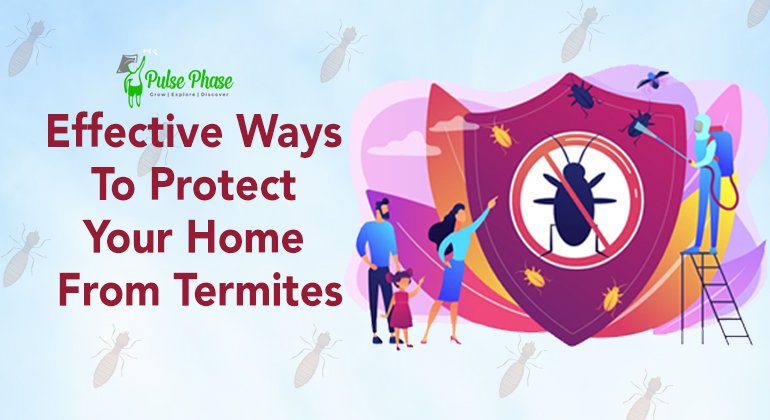Termites can devastate your home, leading to repair costs that skyrocket. Safeguarding your home against these destructive pests is crucial for preserving its structural integrity and value. This detailed article will guide you with Effective ways to protect your home from termites, ensuring a safe and pest-free living environment.
Understanding Termites: The Silent Destroyers
Before diving into prevention methods, it’s essential to understand what termites are and why they pose such a significant threat. Termites are small, wood-eating insects that live in colonies, often called “silent destroyers” because they can inflict substantial damage undetected. Among the various types, subterranean, dry wood, and dampwood termites are the most common culprits affecting homes.
Signs of Termite Infestation
Detecting a termite infestation early can save you a lot of trouble and expense. Here are some common signs of termite activity:
- Mud tubes: Termites build mud tubes to protect themselves from predators and to maintain moisture while traveling between their colony and food sources.
- Discarded wings: After swarming, termites shed their wings. Finding these discarded wings around your home is a clear sign of termite activity.
- Hollow wood: Tap on wooden structures in your home. If they sound hollow, termites might have consumed the interior.
- Frass: Drywood termites leave behind frass, which looks like tiny wood-colored pellets. This is essentially termite droppings.
Effective ways to protect your homes from termites
Regular Inspections: The First Line of Défense
Regular inspections are one of the most effective ways to prevent a termite infestation. Check your home’s foundation, wooden structures, and any areas where wood meets soil. Pay particular attention to basements, crawl spaces, and attics. It’s advisable to have a professional pest control expert inspect your home at least once a year.
Maintain Proper Ventilation and Moisture Control
Termites thrive in moist environments, making proper ventilation and moisture control essential for prevention. Ensure your home has adequate drainage, and that gutters and downspouts are functioning correctly. Use dehumidifiers in basements and crawl spaces to reduce moisture levels, and promptly repair any plumbing leaks to prevent excess moisture.
Use Termite-Resistant Building Materials for protect Home From termites
When constructing or renovating your home, consider using termite-resistant building materials. Some of these materials include:
- Concrete: Termites cannot eat through concrete, making it an excellent choice for foundations and structural supports.
- Pressure-treated wood: This type of wood is treated with chemicals that repel termites.
- Steel: Using steel for structural supports and frames is another effective way to prevent termite damage.
Create a Barrier Between Soil and Wood
One of the most effective ways to prevent termites from entering your home is to create a physical barrier between the soil and any wooden structures. This can be achieved by:
- Concrete foundations: Ensuring your home has a concrete foundation can help keep termites at bay.
- Metal termite shields: Installing metal termite shields around the foundation and other entry points can deter termites.
- Gravel or sand barriers: Using gravel or sand around the perimeter of your home can prevent termites from building their mud tubes.
Chemical Treatments and Baiting Systemsfor protect Home From termites
Chemical treatments and baiting systems are highly effective in preventing and controlling termite infestations. Here are some options:
- Liquid termiticides: Applying liquid termiticides around the foundation of your home creates a barrier that kills termites on contact.
- Termite baits: Bait stations containing slow-acting insecticides can be placed around your home. Termites take the bait back to their colony, effectively eliminating the entire colony over time.
- Boric acid: This natural insecticide can be applied to wood to kill termites and prevent infestations.
Seal Cracks and Crevices
Termites can infiltrate your home through tiny cracks and crevices. Regularly inspect your foundation, walls, and areas around windows and doors for any gaps. Seal these openings with caulk or other suitable materials to block termites from entering.
Landscaping Considerations
Your landscaping choices can significantly impact your home’s vulnerability to termites. Here are some tips:
- Keep wood away from the foundation: Avoid stacking firewood or any other wooden materials next to your home.
- Mulch carefully: While mulch benefits your garden, it can also attract termites. Use it sparingly and keep it at least 15 inches from the foundation.
- Trim trees and shrubs: Ensure that trees and shrubs are not touching your home, as they can provide a bridge for termites to enter.
Professional Pest Control Services
Effective Ways to Protect Your Home from Termites – While DIY methods can be effective, hiring a professional pest control service offers several advantages. Professionals have the expertise and tools to detect and pest control termiticides FMC GSS India products like Biflex Tc, Biflex Plus and Transport Ex to eliminate termite infestations effectively. They also provide ongoing monitoring and maintenance to ensure your home remains termite-free.
Educate Yourself and Stay Vigilant
Education is a powerful tool in the fight against termites. Stay informed about the latest prevention techniques and products. Join local community groups or online forums to share information and learn from others’ experiences. Staying vigilant and proactive is key to protecting your home from termites.
Conclusion
Effective Ways to Protect Your Home from Termites – Protecting your home from termites involves regular inspections, proper maintenance, and proactive preventive measures. By recognizing the signs of termite activity and implementing these effective strategies, you can ensure your home remains safe and structurally sound. Remember, prevention is always better than cure, so take action now to safeguard your property from these destructive pests.
Read More: Which Wall Paint Color is best for your home walls?

